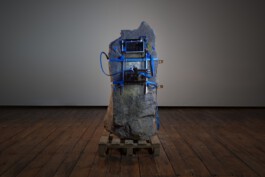
The Petroglyphomat (2014)
Positive vandalism machine to send messages to the distant future
Bachelor Thesis, Tntegrated Design, University of the Arts Bremen
Supervised by Prof. Dennis Paul & Prof. Samuel Nyholm
Thanks to Mulu, Felix, Dennis, Samuel, Jukka, Bene, Raymond, Karin, Leo, Marcel, Björn, Manni, Amir, Christian, Malena, Eileen, Sarah, Rolf, Roland, Vincent, Henning, Ruggero, Tanja, Markus
The Petroglyphomat is a positive vandalism machine which works as a mobile, computer operated milling cutter, that can send messages to a distant future by engraving them into ancient monuments. It is the result of Lorenz Potthast’s bachelor thesis “Communication with the Future” at the University of Arts, Bremen.


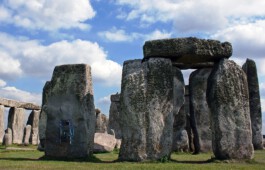
The concept of the Petroglyphomat is a strategical reaction to the technical and financial boundaries which normally limit the possibilities to communicate a message to the future. The idea is to use long existing, important places which most likely will also exist for a long time in the future as infrastructure and expand them with a new communication layer. The machine creates snapshots of our increasingly digitalized environment by converting pixel-based, iconographical symbols into modern stone engravings (petroglyphs).
The Petroglyphomat is the outcome of a detailed research which is documented in the accompanying book “Communication with the Future”. On a theoretical level the book investigates the historical formation of the concept of a future and the origin of the human desire for perpetuate existence . Also it analyzes existing attempts to conserve communication for a long time, gathers the thoughts and conclusions which led to the concept of the Petroglyphomat and documents its development and usage.
The whole project offers a substantial theoretical background and an experimental approach for practical philosophizing about the connection between tradition, transience and our understanding of past, present and future.
The whole project is accompanied by a book which is the origin and the reflection layer for the theoretical background of the project.
The book exists in a circulation of three versions, which differ in their cover. A unique title icon is engraved into slate plates on every book, which is drilled by the Petroglyphomat. The book is written in German, comprises 138 pages and can be separated into four parts.
The first part is a theoretical research about the origin of the interwoven concepts of culture, communication and time. It analyzes the shift from a religious dominated view of what will come, to our modern scientific definition of the future, and unfolds the social and societal changes which are associated with this transition.
The second part aims to collect modern, scientific approaches to conserve messages to the future. It evaluates five different projects and defines key aspects which are important for the long-term conservation of a message.
It is followed by an evaluation which conclusions can be drawn from the theoretical research and how this forms the conceptual background behind the idea of the Petroglyphomat.
The last part is a visual documentation of the whole process, the development of the machine and the final result in the studio and in the wild.
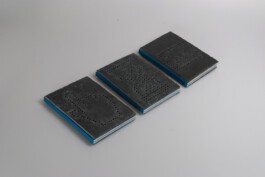
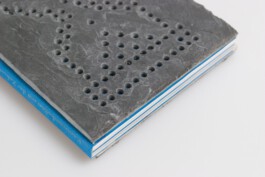
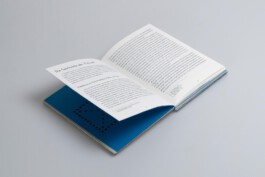
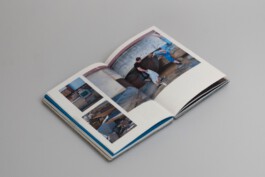
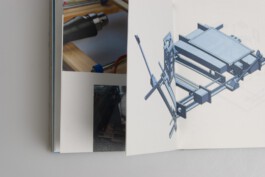
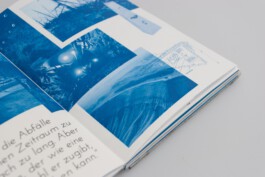
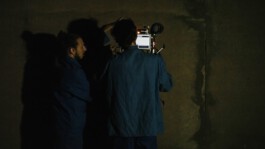
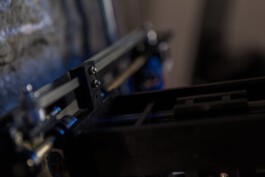


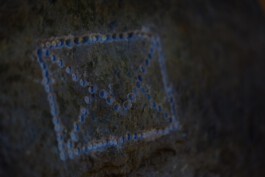
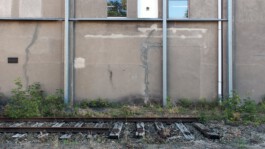
The Petroglyphomat itself is a rudimental CNC milling machine which can drill holes from a predefined pixel matrix into variable materials.
The whole machine is transportable and powered by battery packs which can run up to 3 hours. It weights about 2,5kg and can be transported on the users back. The frame of the Petroglyphomat consists of stainless steel, whereas the rest is constructed from laser cut plastic.
When a targeted destination is reached there are two ways the Petroglyphomat can be mounted on to a surface: It can be tied to a free-standing object with the two integrated belts, or it can be anchored into a flat surface with pre-drilled holes by using the four corner screws.
For controlling the Petroglyphomat the user interacts with the built-in computer via a mouse. From the Interface on the screen he can choose any pixel-based black and white image with up to a resolution of 64×64 pixel to be engraved on the material. The image is then forwarded to an Arduino microcontroller and a motorshield, where it is translated into control commands for the movement of the three motors. Every hole is the representation of a black pixel from the source image. For the actual engraving the drilling unit goes step by step and line by line through the precalculated matrix and drills the holes accordingly.
The wish for self-assertion over ones own transience is a desire that is deeply embedded in the human being. What we
understand today as culture or civilization, is fundamentally based on the ability to preserve communication over time.
Based on the theoretical research, I extracted four aspects which are important for the long-term conservation of communication: The Attractor (How is it ensured that the future will pay attention to the message?), the Channel (In which materiality the communication is manifested?), the Encoding (In what semiotic form the message is composed?) and the Content (What information is transmitted?)
To ensure the attraction of the communication I chose to add them to places which are already culturally and historically charged, like the Pyramids of Gizeh or Stonehenge. Most of these places are made from stone whose materiality offers the best combination of stability in proportion to effort.
Increasing cumulative complexity of a communication system enhances the amount of information it can carry, but also impedes the process of decoding. As a reaction to this the Message and the Encoding consciously don’t try to communicate decodable information, but use digital symbols which only can be interpreted subjectively outside their regular context.
The idea to add modern symbols to ancient monuments is not only a strategic conclusion, but furthermore a provocative act, which questions the traditional concept of who is writing our history.

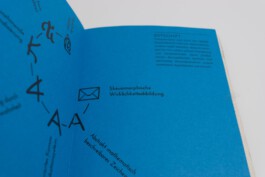
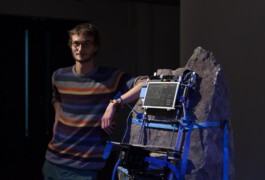


The Petroglyphomat (2014)
Positive vandalism machine to send messages to the distant future
Bachelor Thesis, Tntegrated Design, University of the Arts Bremen
Supervised by Prof. Dennis Paul & Prof. Samuel Nyholm
Thanks to Mulu, Felix, Dennis, Samuel, Jukka, Bene, Raymond, Karin, Leo, Marcel, Björn, Manni, Amir, Christian, Malena, Eileen, Sarah, Rolf, Roland, Vincent, Henning, Ruggero, Tanja, Markus
The Petroglyphomat is a positive vandalism machine which works as a mobile, computer operated milling cutter, that can send messages to a distant future by engraving them into ancient monuments. It is the result of Lorenz Potthast’s bachelor thesis “Communication with the Future” at the University of Arts, Bremen.



The concept of the Petroglyphomat is a strategical reaction to the technical and financial boundaries which normally limit the possibilities to communicate a message to the future. The idea is to use long existing, important places which most likely will also exist for a long time in the future as infrastructure and expand them with a new communication layer. The machine creates snapshots of our increasingly digitalized environment by converting pixel-based, iconographical symbols into modern stone engravings (petroglyphs).
The Petroglyphomat is the outcome of a detailed research which is documented in the accompanying book “Communication with the Future”. On a theoretical level the book investigates the historical formation of the concept of a future and the origin of the human desire for perpetuate existence . Also it analyzes existing attempts to conserve communication for a long time, gathers the thoughts and conclusions which led to the concept of the Petroglyphomat and documents its development and usage.
The whole project offers a substantial theoretical background and an experimental approach for practical philosophizing about the connection between tradition, transience and our understanding of past, present and future.
The whole project is accompanied by a book which is the origin and the reflection layer for the theoretical background of the project.
The book exists in a circulation of three versions, which differ in their cover. A unique title icon is engraved into slate plates on every book, which is drilled by the Petroglyphomat. The book is written in German, comprises 138 pages and can be separated into four parts.
The first part is a theoretical research about the origin of the interwoven concepts of culture, communication and time. It analyzes the shift from a religious dominated view of what will come, to our modern scientific definition of the future, and unfolds the social and societal changes which are associated with this transition.
The second part aims to collect modern, scientific approaches to conserve messages to the future. It evaluates five different projects and defines key aspects which are important for the long-term conservation of a message.
It is followed by an evaluation which conclusions can be drawn from the theoretical research and how this forms the conceptual background behind the idea of the Petroglyphomat.
The last part is a visual documentation of the whole process, the development of the machine and the final result in the studio and in the wild.












The Petroglyphomat itself is a rudimental CNC milling machine which can drill holes from a predefined pixel matrix into variable materials.
The whole machine is transportable and powered by battery packs which can run up to 3 hours. It weights about 2,5kg and can be transported on the users back. The frame of the Petroglyphomat consists of stainless steel, whereas the rest is constructed from laser cut plastic.
When a targeted destination is reached there are two ways the Petroglyphomat can be mounted on to a surface: It can be tied to a free-standing object with the two integrated belts, or it can be anchored into a flat surface with pre-drilled holes by using the four corner screws.
For controlling the Petroglyphomat the user interacts with the built-in computer via a mouse. From the Interface on the screen he can choose any pixel-based black and white image with up to a resolution of 64×64 pixel to be engraved on the material. The image is then forwarded to an Arduino microcontroller and a motorshield, where it is translated into control commands for the movement of the three motors. Every hole is the representation of a black pixel from the source image. For the actual engraving the drilling unit goes step by step and line by line through the precalculated matrix and drills the holes accordingly.
The wish for self-assertion over ones own transience is a desire that is deeply embedded in the human being. What we
understand today as culture or civilization, is fundamentally based on the ability to preserve communication over time.
Based on the theoretical research, I extracted four aspects which are important for the long-term conservation of communication: The Attractor (How is it ensured that the future will pay attention to the message?), the Channel (In which materiality the communication is manifested?), the Encoding (In what semiotic form the message is composed?) and the Content (What information is transmitted?)
To ensure the attraction of the communication I chose to add them to places which are already culturally and historically charged, like the Pyramids of Gizeh or Stonehenge. Most of these places are made from stone whose materiality offers the best combination of stability in proportion to effort.
Increasing cumulative complexity of a communication system enhances the amount of information it can carry, but also impedes the process of decoding. As a reaction to this the Message and the Encoding consciously don’t try to communicate decodable information, but use digital symbols which only can be interpreted subjectively outside their regular context.
The idea to add modern symbols to ancient monuments is not only a strategic conclusion, but furthermore a provocative act, which questions the traditional concept of who is writing our history.



